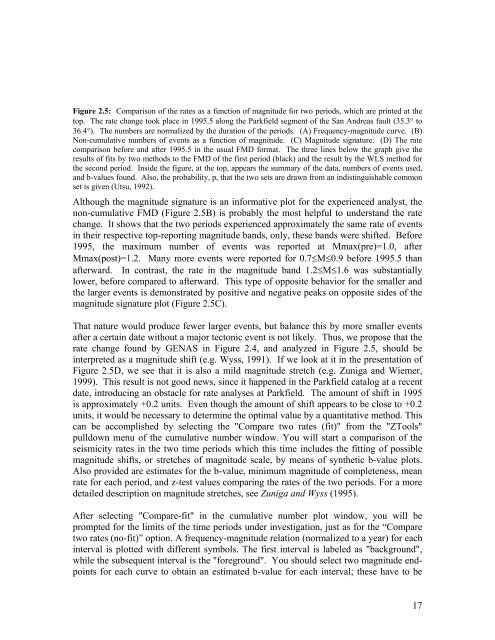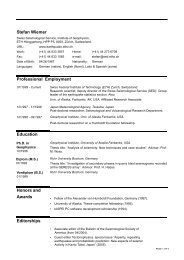zmap a tool for analyses of seismicity patterns typical applications ...
zmap a tool for analyses of seismicity patterns typical applications ...
zmap a tool for analyses of seismicity patterns typical applications ...
Create successful ePaper yourself
Turn your PDF publications into a flip-book with our unique Google optimized e-Paper software.
Figure 2.5: Comparison <strong>of</strong> the rates as a function <strong>of</strong> magnitude <strong>for</strong> two periods, which are printed at the<br />
top. The rate change took place in 1995.5 along the Parkfield segment <strong>of</strong> the San Andreas fault (35.3° to<br />
36.4°). The numbers are normalized by the duration <strong>of</strong> the periods. (A) Frequency-magnitude curve. (B)<br />
Non-cumulative numbers <strong>of</strong> events as a function <strong>of</strong> magnitude. (C) Magnitude signature. (D) The rate<br />
comparison be<strong>for</strong>e and after 1995.5 in the usual FMD <strong>for</strong>mat. The three lines below the graph give the<br />
results <strong>of</strong> fits by two methods to the FMD <strong>of</strong> the first period (black) and the result by the WLS method <strong>for</strong><br />
the second period. Inside the figure, at the top, appears the summary <strong>of</strong> the data, numbers <strong>of</strong> events used,<br />
and b-values found. Also, the probability, p, that the two sets are drawn from an indistinguishable common<br />
set is given (Utsu, 1992).<br />
Although the magnitude signature is an in<strong>for</strong>mative plot <strong>for</strong> the experienced analyst, the<br />
non-cumulative FMD (Figure 2.5B) is probably the most helpful to understand the rate<br />
change. It shows that the two periods experienced approximately the same rate <strong>of</strong> events<br />
in their respective top-reporting magnitude bands, only, these bands were shifted. Be<strong>for</strong>e<br />
1995, the maximum number <strong>of</strong> events was reported at Mmax(pre)=1.0, after<br />
Mmax(post)=1.2. Many more events were reported <strong>for</strong> 0.7≤M≤0.9 be<strong>for</strong>e 1995.5 than<br />
afterward. In contrast, the rate in the magnitude band 1.2≤M≤1.6 was substantially<br />
lower, be<strong>for</strong>e compared to afterward. This type <strong>of</strong> opposite behavior <strong>for</strong> the smaller and<br />
the larger events is demonstrated by positive and negative peaks on opposite sides <strong>of</strong> the<br />
magnitude signature plot (Figure 2.5C).<br />
That nature would produce fewer larger events, but balance this by more smaller events<br />
after a certain date without a major tectonic event is not likely. Thus, we propose that the<br />
rate change found by GENAS in Figure 2.4, and analyzed in Figure 2.5, should be<br />
interpreted as a magnitude shift (e.g. Wyss, 1991). If we look at it in the presentation <strong>of</strong><br />
Figure 2.5D, we see that it is also a mild magnitude stretch (e.g. Zuniga and Wiemer,<br />
1999). This result is not good news, since it happened in the Parkfield catalog at a recent<br />
date, introducing an obstacle <strong>for</strong> rate <strong>analyses</strong> at Parkfield. The amount <strong>of</strong> shift in 1995<br />
is approximately +0.2 units. Even though the amount <strong>of</strong> shift appears to be close to +0.2<br />
units, it would be necessary to determine the optimal value by a quantitative method. This<br />
can be accomplished by selecting the "Compare two rates (fit)" from the "ZTools"<br />
pulldown menu <strong>of</strong> the cumulative number window. You will start a comparison <strong>of</strong> the<br />
<strong>seismicity</strong> rates in the two time periods which this time includes the fitting <strong>of</strong> possible<br />
magnitude shifts, or stretches <strong>of</strong> magnitude scale, by means <strong>of</strong> synthetic b-value plots.<br />
Also provided are estimates <strong>for</strong> the b-value, minimum magnitude <strong>of</strong> completeness, mean<br />
rate <strong>for</strong> each period, and z-test values comparing the rates <strong>of</strong> the two periods. For a more<br />
detailed description on magnitude stretches, see Zuniga and Wyss (1995).<br />
After selecting "Compare-fit" in the cumulative number plot window, you will be<br />
prompted <strong>for</strong> the limits <strong>of</strong> the time periods under investigation, just as <strong>for</strong> the “Compare<br />
two rates (no-fit)” option. A frequency-magnitude relation (normalized to a year) <strong>for</strong> each<br />
interval is plotted with different symbols. The first interval is labeled as "background",<br />
while the subsequent interval is the "<strong>for</strong>eground". You should select two magnitude endpoints<br />
<strong>for</strong> each curve to obtain an estimated b-value <strong>for</strong> each interval; these have to be<br />
17



